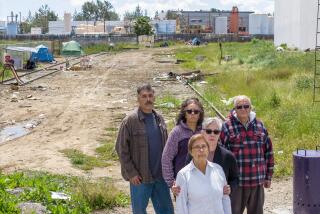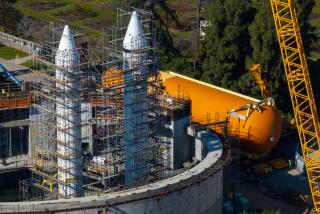Adhesive Problem With Columbia Tank Is Cited
- Share via
HOUSTON — A former engineer at the plant where NASA fuel tanks are built said Monday that a layer of epoxy on the tank used by the Columbia was not applied properly before insulation was sprayed on top of it, a mistake that might have contributed to the space shuttle’s Feb. 1 destruction.
John Ehlers, who no longer works at the Lockheed Martin Space Systems Co. Michoud Assembly Facility, said in an interview that there were problems 2 1/2 years ago with the application of an epoxy primer during construction of one of the shuttle’s external fuel tanks.
The application of the primer, used largely as an adhesive for foam insulation, is a critical and delicate process, said Joe Marcus, Michoud’s former vice president of production operations, who retired last summer. If the primer is not given sufficient time to dry, moisture can form and its seal can be weakened. If it is allowed to dry for too long, its bonding ability can be impaired.
In this case, the primer did not dry properly in the time allotted, Ehlers said. That could have been because of a variety of problems, he said. The epoxy, he said, might have been too thick, its chemical composition might have been wrong or the ventilation might have been faulty at the east New Orleans plant. In any case, he said, “it wasn’t dry. Obviously, there was a problem.”
Ehlers is one of several former Michoud employees who have said in recent weeks that they witnessed problems or questionable workmanship at the plant.
Officials dismissed Ehlers’ allegation in part because he learned of it during an informal lunchtime conversation with Bruce Wright, a former quality control supervisor at Michoud. Wright told the Miami Herald he would have filed a formal allegation but was told by a supervisor not to.
The 154-foot-long tank was later used to propel the Columbia into orbit. Ehlers said the primer problem appeared most acute on the portion of the tank that connects to the shuttle, the same area that is believed to have shed the foam that struck the Columbia on liftoff Jan. 16.
Marion LaNasa, spokesman for Michoud, defended the company’s safety standards. LaNasa said Michoud performs 47,000 inspections during the construction of each tank.
The Columbia Accident Investigation Board, the panel appointed by NASA to find the cause of the accident, is concerned about the application of foam insulation and is reviewing the construction of fuel tanks at the Michoud plant, said Air Force Lt. Col. Woody Woodyard, a board spokesman.
“This is certainly something that they are going to be looking at,” Woodyard said.
LaNasa questioned the credibility of former workers who are raising questions about the plant.
“They had many, many opportunities and many different channels to have surfaced that same concern when they were employees,” LaNasa said.
“If they didn’t do it then, why not?”
Before he was laid off in 2002, the bulk of Ehlers’ job was reviewing claims of “nonconformance” to engineering standards, he said. Normally, quality control officials at Michoud would present allegations to Ehlers, who would review them and take them to engineers, who would make repairs. Ehlers also presented the documents to NASA to ensure that officials there agreed with the diagnoses.
Ehlers, then a product assurance engineer at Michoud, said he learned of the concerns about the epoxy more than two years ago during a conversation with Wright
Ehlers said he was prohibited from raising the issue unless quality control officials contacted him. In this case, he received no request. Wright told the Herald that he wanted to file a formal report but that a supervisor discouraged him from doing so because the report would be forwarded to NASA.
When the space shuttle broke apart Feb. 1, killing its crew, Ehlers became concerned, he said, that the incident could represent what is known at NASA as “process creep” -- problems that can result from hidden, subtle changes to techniques and safety standards.
Ehlers immediately got in touch with Michoud’s ethics officer, Feltus Kennedy. Kennedy asked Ehlers to write a letter, and Ehlers hand-delivered a memo on Feb. 4. Kennedy did not return calls for comment.
“I wanted to make the company aware,” Ehlers said. “If it was a contributing factor, I would like to prevent this from happening again.”
In the letter, Ehlers suggested that workers did not want to take the time to strip the epoxy and start over once the problem was detected. So they did “touch-up work,” which extended the drying time for the epoxy. That’s not engineering, Ehlers suggested, it’s guesswork.
Ron Wetmore, vice president of Michoud’s external tank project, called the allegations nonsensical. He said the “touch-up” work is common.
Others were not so quick to dismiss Ehlers’ concerns.
“It is not beyond the realm of reason to think there is an optimum time -- that the primer’s ability to take on [foam insulation] would be time-sensitive,” Marcus said.
Ehlers said he was fired twice because of cutbacks, not because of his performance. He had been scheduled to return to Michoud for a third round of employment in February, but his posting was canceled because of the shuttle accident.
*
Times staff writer Dana Calvo contributed to this report.
More to Read
Sign up for Essential California
The most important California stories and recommendations in your inbox every morning.
You may occasionally receive promotional content from the Los Angeles Times.














